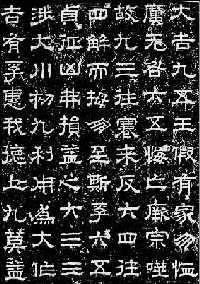Masterpieces of Xiaozhuan of this period include Taishan Keshi (stone inscription on theMount Tai) and Langyatai Keshi (stone inscription on Langya Terrace). Elucidations of the Signs and Explications of the Graphs, compiled by Xu Shen, included 9,353 Xiaozhuan characters.
Though Xiaozhuan did not emerge until a long time after characters came into existence, it boasts a large number and played a special role in the development ofChinese characters, acting as the bridge between ancient characters and modern characters.
Representative: Li Si
 Official Script
Official Script
 |
|
LishuCalligraphy by Cai Yong
|
Lishu(official script) is developed from wild writing of Liuwen, a kind of calligraphy with round shape and many strokes. Because writing in Liuwen is time-consuming, people tended to write a bit more wildly and changed orderly arced strokes into relatively flat and straight in informal occasions. Lishu came into being in the Qin State of the late Warring States Period (475-221BC) and gradually became popular.
Lishu includes three types -- Qin Li of the Qin Dynasty (221-206BC), Han Li of theHan Dynasty(206BC-220AD) and Bafen calligraphy. Qin Li refers to the simplified characters adopted for use during the reign of Qin Emperor Shihuang. By the Han Dynasty, the calligraphy in daily life was Lishu but its shape and handwriting got much development. Bafen calligraphy refers to the 80% style, which contracts the lesser seal calligraphy by a subtraction of 20%.
In fact, the simplified Chinese characters popular in the Qin Dynasty emerged before Qinshihuang unified the eight calligraphic styles. According to archeological findings, characters on some wooden plates and bamboo pieces from the Warring States Period and weapons, and lacquers and potteries from the Qin Dynasty were simpler than theZhuanshu(seal script). The shape of the Chinese characters changed from round to square and the strokes tend to be wave-shaped. This was the beginning of Lishu.
The emergence of Lishu is an important reform in Chinese calligraphy, calling an end to the 3,000-year history of archaic Chinese characters and replacing them with a simpler writing form. Signs and designs almost disappeared, and characters became solely symbols.
Representative: Cai Yong
